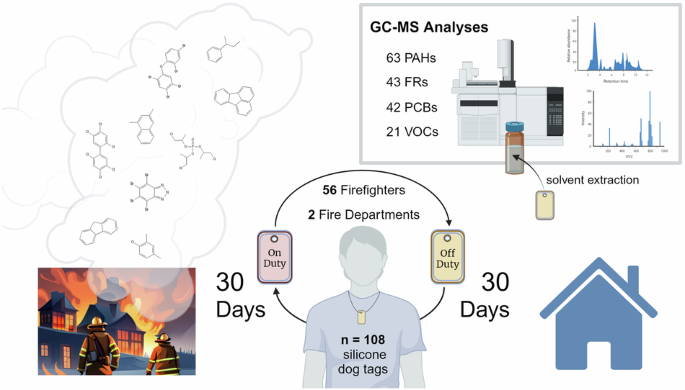利用硅胶采样器满足对消防员进行个人接触监测的需求。
IF 4.7
3区 医学
Q2 ENVIRONMENTAL SCIENCES
Journal of Exposure Science and Environmental Epidemiology
Pub Date : 2024-07-20
DOI:10.1038/s41370-024-00700-y
引用次数: 0
摘要
背景:消防员在工作中会接触到危险的化学混合物。硅胶被动采样装置可捕捉到一段时间内的独特暴露,对参与者的影响最小,并可对广泛的化学空间进行分析:目标:消防员在执勤和不执勤时佩戴硅胶狗牌,以测量个人暴露量、确定潜在的职业暴露量,并评估其与职业变量的关系,包括火灾响应频率、级别和消防员年限:从堪萨斯城大都会地区出警量相对较高和较低的两个消防队招募了 56 名消防员,让他们在执勤和休班时佩戴两种不同的硅胶狗牌作为被动采样器。每个狗牌累计佩戴 30 天。采用气相色谱法和质谱法分析了狗牌中的 43 种阻燃剂 (FR)、21 种挥发性有机化合物 (VOC)、42 种多氯联苯 (PCB) 和 63 种多环芳烃 (PAH):结果:共检测出 92 种化学物质,其中有 8 种化学物质以前在消防员接触研究中没有报道过。根据执勤犬牌与非执勤犬牌相比接触量增加的程度和频率,5 种多溴联苯醚和仲丁基苯被确定为潜在的职业接触物;据作者所知,仲丁基苯和多溴联苯醚 49 以前从未在消防员接触研究中报道过。对这六种化合物进行的多变量分析表明,消防员级别、火灾响应率和消防服务年限并不是职业暴露增加的指标。在出警率低的部门中,执勤消防员的多溴联苯醚暴露量最大。高出警率部门消防员的狗牌占多氯联苯检出量的 75%;这可能是一次特殊的消防响应造成的。此外,对于一些消防员来说,配对的值班和非值班标签之间的化学物质总暴露量具有可测量的相似性:本研究使用佩戴在脖子上的狗牌式个人硅胶被动采样器,量化了消防员在岗样本中与配对的非在岗样本中的几类化学物质的职业接触情况:阻燃剂、挥发性有机化合物和多氯联苯。五种多溴联苯醚和仲丁基苯被确定为潜在的职业接触物,但它们在执勤标签中的普遍程度与火灾响应频率、消防员等级或消防员在消防部门的工作年限无关。此外,同一消防员在执勤和非执勤标签中接触到的化学物质具有相似性,因此需要进一步调查影响职业和准职业接触的个人行为。本文章由计算机程序翻译,如有差异,请以英文原文为准。


Addressing the need for individual-level exposure monitoring for firefighters using silicone samplers
Firefighters are occupationally exposed to hazardous chemical mixtures. Silicone passive sampling devices capture unique exposures over time with minimal impact to the participant and allow for the analysis of a broad chemical space. Silicone dog tags were worn by firefighters while on- and off-duty to measure individual exposures, identify potential occupational exposures, and assess their relation to occupational variables including fire response frequency, rank, and years as a firefighter. Fifty-six firefighters were recruited from two fire departments with relatively high and low call volumes in the Kansas City metropolitan area to wear two different silicone dog tags as passive samplers while on- and off-duty. Each dog tag was worn for a cumulative 30-day exposure period. Extracts of the dog tags were analyzed with gas chromatography, mass spectrometry methods for 43 flame retardants (FRs), 21 volatile organic compounds (VOCs), 42 polychlorinated biphenyls (PCBs), and 63 polycyclic aromatic hydrocarbons (PAHs). Ninety-two total chemicals were detected, with eight chemicals not previously reported in firefighter exposure studies. Based on the magnitude and frequency of increased exposure in on-duty dog tags, relative to paired off-duty dog tags, five PBDEs and sec-butylbenzene were identified as potential occupational exposures; sec-butylbenzene and PBDE 49 have not previously been reported in firefighter exposure studies to the authors’ knowledge. Multivariate analyses for these six compounds indicated that firefighter rank, fire response rates, and years in the fire service were poor indicators of increased occupational exposure. The greatest on-duty exposures to PBDEs were found in the low-call volume department among operational firefighters. Dog tags from firefighters at the high-call volume department accounted for 75% of PCB detections; one particular fire response may have contributed to this. Additionally, there was measurable similarity in total chemical exposure profiles between paired on- and off-duty tags for some firefighters.
求助全文
通过发布文献求助,成功后即可免费获取论文全文。
去求助
来源期刊
CiteScore
8.90
自引率
6.70%
发文量
93
审稿时长
3 months
期刊介绍:
Journal of Exposure Science and Environmental Epidemiology (JESEE) aims to be the premier and authoritative source of information on advances in exposure science for professionals in a wide range of environmental and public health disciplines.
JESEE publishes original peer-reviewed research presenting significant advances in exposure science and exposure analysis, including development and application of the latest technologies for measuring exposures, and innovative computational approaches for translating novel data streams to characterize and predict exposures. The types of papers published in the research section of JESEE are original research articles, translation studies, and correspondence. Reported results should further understanding of the relationship between environmental exposure and human health, describe evaluated novel exposure science tools, or demonstrate potential of exposure science to enable decisions and actions that promote and protect human health.

 求助内容:
求助内容: 应助结果提醒方式:
应助结果提醒方式:


